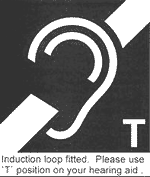|
How does a loop system differ from an infa-red system?Induction loops and infrared systems create a new path for sound between the sound source and the hearing impaired listener with either an inductive (magnetic) or infrared signal which is not affected by other sounds. (19)Using a loop system, the reciever of the sound/magnetic field is the listener's hearing aid. However, with an infared system the reciever that converts the signal back to sound is specific for infared systems. Both systems have a defined area of use and the sound heard by people who are not using a receiver is unaffected. (19) Induction loops and infared systems are used in places of worships, theatres, banks, post offices, cinemas lecture/conference halls as well as in some shopping centres, bus and train stations etc. (19) The use of induction loops is more common as there is no need to use a special receiver.
|
Anywhere displaying this logo will have an induction loop fitted
What is an induction loop?An induction loop enables people wearing a hearing aid that can be switched to the 'T' position to hear specific sounds more effectively. Induction loops are fed by loop amplifiers and surround the audience/customer area (or may alternatively only encircle a portion of the room). The amplifier recieves a signals from a microphone that picks up sound from the sound source i.e. this may be a bank employee, an actor, a lecturer etc.. and an electric current passes through the loop thereby creating a magnetic field that alters with the sound source. This magnetic field can be detected by people using a loop listening aid or a hearing aid switched to the 'T' position. (19)
This means that the sound is very clear as there is little background noise- as only sounds picked up by the microphone create the magnetic field that is picted up by the hearing aid.
A loop is simply made from insulated cable, but depending on the amplifier, two or more turns of cable may be required.(19)
FACTORS AFFECTING A LOOP
External factors may affect how well a loop works:
- Even if the loop itself works properly, hearing aid users may hear magnetic interference from electrical equipment and wiring, such as fluorescent lights, light dimming systems or power cables. This interference is picked up directly by their hearing aids. You can usually identify sources of interference using a portable field strength meter, hearing aid or loop listener. If it cannot be prevented or reduced, you must assess the interference to see if it will be acceptable to people using the loop.(19)
2.Loop systems are designed for users within the area of the loop, but there is always some overspill as walls, ceilings and floors do not block magnetic fields. What this means is that hearing aid users outside the room fitted with an induction loop may be able to overhear conversations if their hearing aids are switched to "T". Adjoining rooms and rooms directly above and below can also be affected by overspill. You may want to bear this in mind if you are thinking of using an induction loop for confidential meetings or if you are fitting more than one loop. This is particularly important if you provide advice on sensitive personal issues that may come up during medical or legal consultations, or in court and tribunal rooms.3.An induction loop may cause interference in other parts of a sound system. This can happen if the loop cable runs close to other audio cables. Microphone cables are especially vulnerable to such interference. In general, carefully routing the cables prevents this problem.4.Metal in buildings can have an unpredictable effect on loop systems. The loop may produce a weaker inductive signal than expected if the metalwork in the area of the loop is substantial, and the signal strength may vary from seat to seat in the listening area. An induction loop specialist may be able to predict this and suggest solutions, but installation is likely to involve trial and error.British Standard Code of PracticeLoop systems in public buildings should be installed to the British Standard Code of Practice for Audio Frequency Induction Loop Systems BS 7594. If you quote this code of practice in all specifications and contracts, it will mean that your induction loop system should be designed and installed to professional standards, works properly, is safe and meets regulations. Portable loopsPortable loops cover a small area and can be packed away after use. They are useful if you do not need a permanent system installed or if the loop is needed in different rooms. (19)
Below is another example of a loop system symbol that may be displayed at a venue fitted with a loop system. The symbols come in all colours and sizes. Not that the symbol also includes the letter 'T' to indicate that hearing aids should be switched to the 'T' position.

(The symbol above is taken from http://www.dciiberia.com/hearing.htm)
For more on hearing aids click here ----->